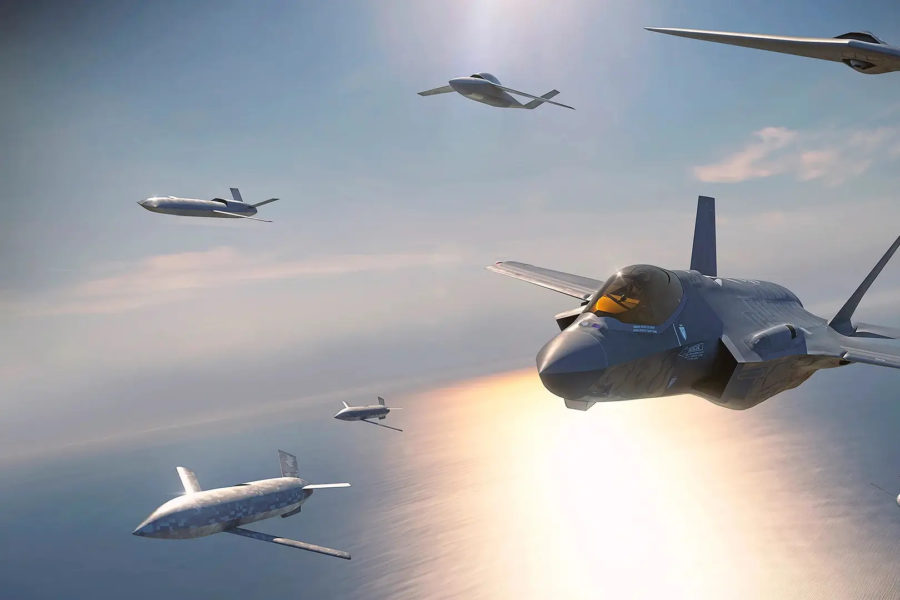DAYTON, Ohio—The Air Force will announce key new details about its Collaborative Combat Aircraft program at AFA’s Air, Space, and Cyber Conference in September, including future force design, acquisition strategy, and cooperation with the Navy, according to a top service official.
Brig. Gen. (Lt. Gen. select) Dale White, program executive officer for fighters and advanced aircraft, teased the announcement while speaking with reporters July 31 at the Life Cycle Industry Days conference.
Both the Air Force and Navy are pursuing programs to develop autonomous drones that will pair with manned aircraft, and the two services have reportedly held discussions about how to collaborate. Asked how the Air Force and Navy plan to orchestrate the handoff of targets between such aircraft, White suggested “there will be a larger discussion” of CCAs—touching on how that fleet will integrate with the Navy and USAF’s current tactical air inventory—at the ASC 2023 conference, which takes place Sept. 11-13.
“I’ll just give you a little teaser [that] there’s four specific areas that we’re focused on,” White said. “And those four specific areas will define how we pick out this path” toward a CCA capability.
White did not elaborate on the four focus areas but seemed to suggest they will at least partially involve how CCAs will tie into the Joint All-Domain Command and Control (JADC2) system.
The Air Force is “maturing our force design” for CCAs in accord with joint force design, White added, “and the Navy is doing the same.”
While the two services may have some differing views on how CCAs should be employed, “you’re starting to see that integration coming together better, because technology becomes that bond; that glue that bonds us together,” White said. “And so while we may have different requirements on the fringe, by and large, the tacair, or air dominance mission is the same regardless of what uniform you wear.”
He added that “the requirements of the end state may be a little different on the fringe. But the capability and technologies are the same.”
White also said the Air Force has had consistent collaboration with the Navy on CCAs, and the two branches are taking “that teaming approach, knowing what the other is doing, making sure we’re protecting interoperability” in the joint fight. That collaboration has also been key to ensuring the services don’t waste time or resources duplicating efforts.
From operators to the highest levels of the Pentagon, the Air Force and Navy have been “working consistently towards similar outcomes,” White added.
“We have to be in lockstep,” he said of the ability to share data and targets, adding “We’re finding architectures and standards become the foundation of interoperability. … So we’ll lay out more specific detail on that” at the ASC conference.
Air Force leaders have said they will seek at least 1,000 of the autonomous CCAs to augment the manned fighter fleet, with a ratio of at least two drones per fighter and as many as five. The Navy, for its part, has said it is working toward a carrier air wing that will be more than 60 percent uncrewed aircraft by the early 2030s.
The next step in the CCA plan is focused on force design, White said.
White also said the Air Force has to “break the mold” of how requirements are written and answered in developing new aircraft, echoing comments of Chief of Staff Gen. Charles Q. Brown Jr. at the LCID conference. Specifically, Brown suggested the service should move away from “specific, detailed requirements” and toward a system where new capabilities are constantly introduced, on an operationally-relevant timetable.
In the case of CCAs, White said both Air Force Secretary Frank Kendall and service acquisition executive Andrew Hunter “have both alluded to that iterative nature” of the program, “that is defined by both technology as well as the operator.”
“Let me be clear: we are on a journey,” White said. “And so on that journey we will learn and we will continue to iterate. And as we go through constant refinement, and we go through testing … that will greatly inform where we’re going. And when you think about the agility we’ve invested in the acquisition strategy, we’re going to be able to leverage that moreso than previously.”

